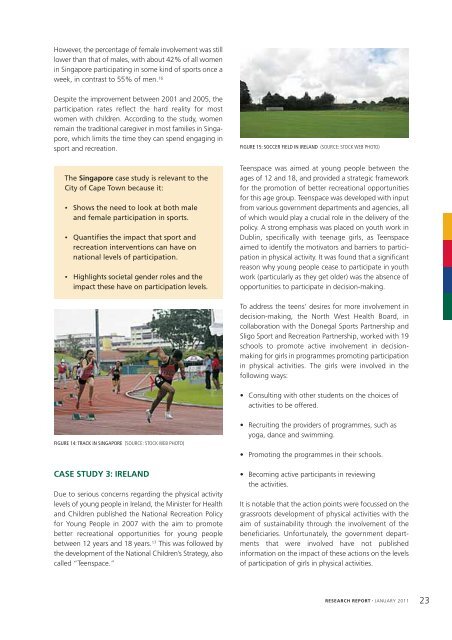Recreation Study
Recreation Study
Recreation Study
- No tags were found...
You also want an ePaper? Increase the reach of your titles
YUMPU automatically turns print PDFs into web optimized ePapers that Google loves.
However, the percentage of female involvement was stilllower than that of males, with about 42% of all womenin Singapore participating in some kind of sports once aweek, in contrast to 55% of men. 16Despite the improvement between 2001 and 2005, theparticipation rates reflect the hard reality for mostwomen with children. According to the study, womenremain the traditional caregiver in most families in Singapore,which limits the time they can spend engaging insport and recreation.The Singapore case study is relevant to theCity of Cape Town because it:• Shows the need to look at both maleand female participation in sports.• Quantifies the impact that sport andrecreation interventions can have onnational levels of participation.• Highlights societal gender roles and theimpact these have on participation levels.FIGURE 15: SOCCER FIELD IN IRELAND (SOURCE: STOCK WEB PHOTO)Teenspace was aimed at young people between theages of 12 and 18, and provided a strategic frameworkfor the promotion of better recreational opportunitiesfor this age group. Teenspace was developed with inputfrom various government departments and agencies, allof which would play a crucial role in the delivery of thepolicy. A strong emphasis was placed on youth work inDublin, specifically with teenage girls, as Teenspaceaimed to identify the motivators and barriers to participationin physical activity. It was found that a significantreason why young people cease to participate in youthwork (particularly as they get older) was the absence ofopportunities to participate in decision-making.To address the teens’ desires for more involvement indecision-making, the North West Health Board, incollaboration with the Donegal Sports Partnership andSligo Sport and <strong>Recreation</strong> Partnership, worked with 19schools to promote active involvement in decisionmakingfor girls in programmes promoting participationin physical activities. The girls were involved in thefollowing ways:• Consulting with other students on the choices ofactivities to be offered.FIGURE 14: TRACK IN SINGAPORE (SOURCE: STOCK WEB PHOTO)CASE STUDY 3: IRELANDDue to serious concerns regarding the physical activitylevels of young people in Ireland, the Minister for Healthand Children published the National <strong>Recreation</strong> Policyfor Young People in 2007 with the aim to promotebetter recreational opportunities for young peoplebetween 12 years and 18 years. 17 This was followed bythe development of the National Children’s Strategy, alsocalled “Teenspace.”• Recruiting the providers of programmes, such asyoga, dance and swimming.• Promoting the programmes in their schools.• Becoming active participants in reviewingthe activities.It is notable that the action points were focussed on thegrassroots development of physical activities with theaim of sustainability through the involvement of thebeneficiaries. Unfortunately, the government departmentsthat were involved have not publishedinformation on the impact of these actions on the levelsof participation of girls in physical activities.RESEARCH REPORT JANUARY 201123


